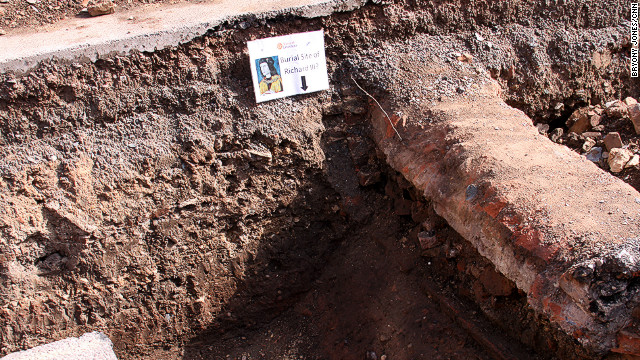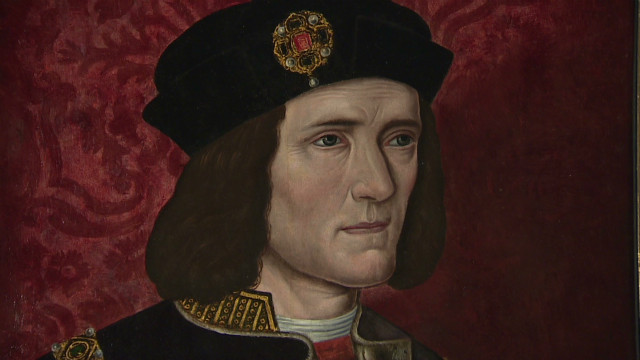"He's been waiting hundreds of years," says one woman, gesturing towards the archway up ahead with a smile. "It won't kill us to hang on for half an hour."
"He" is Richard III, one of the most famous kings of England, remembered by school children and Shakespeare aficionados alike as a notorious villain, hunchbacked and hateful, accused of killing his own nephews, the "Princes in the Tower," to usurp the throne, and whose whereabouts were, until recently, a complete mystery.
The history books record that in August 1485, Richard - the last English king to die in battle - rode out from Leicester, in central England, to the Battle of Bosworth Field. There he met his end; his body was returned to the city days later, ignominiously lashed to a packhorse.
While other monarchs might have been granted all the pomp and ceremony of a state funeral, as a defeated warrior, Richard was accorded no such regal treatment. Instead his naked remains were put on display to prove to supporters and opponents alike that he really was dead, before being hastily buried in a nearby church.
Which is why, more than 520 years on, a crowd has gathered in this municipal car park, though there's little to explain their excitement - at first glance, the most remarkable thing seems to be the lack of vehicles in the worn white parking bays.
Overlooked by the spire of the nearby cathedral, fluorescent overall-clad archaeologists and historians gather near a hole in the ground. It looks like any other set of roadworks, the surface scraped back to reveal layers of earth.

Some of them weren't so sure at first, however. "It seemed like such a harebrained scheme," Richard Buckley, the lead archaeologist on the project, tells CNN. "We didn't expect to find anything."
Applying for permission to dig at the site, and potentially exhume a body, or bodies, Buckley says he wrote: "In the unlikely event that we find the remains of Richard III..."
Nonetheless, at the tail end of last summer, a team of experts dug three trenches across the site and began hunting for evidence of the long-lost friary, where Richard III was recorded to have been buried.
The search turned up traces of the building, and then something altogether more exciting: A human skeleton, complete with evidence of battle wounds -- a blow to the head, and an arrow in the back -- and scoliosis, or curvature of the spine.
"I didn't think it was likely to be him at first," explains bioarchaeologist Jo Appleby, who excavated the remains. "The skull didn't seem to be in quite the right place -- now we know that's because of the scoliosis -- but it didn't seem to 'go' with the legs.
"When I lifted the skull and saw the injury, a little alarm bell started to ring, but I told myself perhaps someone had dug into the grave at a later date and hit it with a spade, so I thought 'Don't say anything yet.'
"I cleared the arms and legs, and then went up the spine, hunting for vertebrae, [but] they weren't there, they weren't where I expected them to be. Instead they went in completely the wrong direction. At that point, I thought 'Hang on!'"
"Someone came over and said 'I think you need to see this,'" Buckley says. "We were looking at something else, so I said 'I'm a bit busy at the moment,' and they said 'No, no, you really need to see this.'"
They were stunned to discover the remains were in surprisingly good condition - particularly given the fact they were apparently laid to rest in a simple shroud, with no coffin to protect them.
"There have been so many changes to the site over the years that the chances of finding the remains were so slim," says local historian David Baldwin. "It wouldn't have been at all surprising had they been destroyed."
As a shiver of anticipation spread across the site, one figure sat, deathly pale and shaking, at the side of the trench.
Philippa Langley had spent years trying to convince archaeologists and authorities alike to allow the dig for Richard III to go ahead. Now she watched, in shock, as the search she had championed for so long reached its climax.
"It's been a real labor of love," she told CNN. "Three years of hard work and tough graft, of people saying we'd never find him, but it looks like it may have paid off."
Langley, a screenwriter, became intrigued by Richard III after reading a book about him on holiday, and quickly decided he would make a perfect subject for a film.
"His story absolutely blew me away," she says. "I asked myself 'Why has nobody written this? Why has nobody told this guy's story?' Robin Hood has had his moment in the cinema, now it's time for Richard III to have his time on the big screen too.
"I decided I needed to do some research -- I needed to know who he was, what he was about, I needed to get inside his head, talk his talk, walk his walk, so I went to Leicester and to Bosworth, but I felt there was no fitting conclusion to the story."
So she decided to help create one, by forcing historians to look again at his story, to find "the real man, and not the myth," because, she believes: "With the truth, he'll finally be able to rest in peace."
Langley hopes the physical evidence found so far will be enough to make people rethink their image of Richard III as a caricature villain.
"It disproves the Tudor writers who claimed terrible things about him: That he was hunchbacked, that he was two years in the womb, that he was born with hair and teeth," she says.
"Instead we can see that he was a strong, capable man, and it blows all those misconceptions away. It gives us so much information about Richard, the real Richard, before the Tudor writers got to him.
"I'm not looking for a saint, but a real man -- if I've got to portray him on a big screen I want to show the real him. He wasn't always great and good, but that's fine, if he was, we'd all be bored to death."
She has even been in talks with Leicestershire lad turned Hollywood hero Richard Armitage -- last seen as Thorin Oakenshield in "The Hobbit" -- to play the king.
"He was born to play the role," she explains. "He's an amazing doppelganger for Richard III, he was born a couple of miles from Bosworth on the anniversary of Richard's death, and he was even named after him."
The film won't be the first attempt to rehabilitate Richard III in the eyes of the general public - mystery writer Josephine Tey tried it in the 1950s with "The Daughter of Time," in which her detective hero "discovers" the truth about the much-maligned monarch.
It was this book which first sparked the curiosity of Michael Ibsen, prompting him to rethink the image he had grown up with, of Richard III as "this evil figure who killed the Princes in the Tower."
Now the Canadian-born cabinetmaker finds himself at the heart of the story, with a role he could never have imagined when he read Tey's novel 20 years ago: The potential DNA match for a long-dead king of England.
"Of course, I'd rather be related to a benign king figure than a brutal murderer, so it's hard not to be biased, but some of the history is so vitriolic, I'm a little suspicious -- can he really have been that bad?"
Historian John Ashdown Hill, author of "The Last Days of Richard III," tracked down Ibsen's British-born mother Joy in 2004.
"She knew she had an illustrious family background - they were from the upper class, but had fallen on hard times -- but she had no idea that this was in her past," Ibsen says.
Ashdown Hill explained that as a direct - if long-distant -- female relative of Richard III's sister, Anne of York, she and her children should have the same mitochondrial DNA (mtDNA) as Richard III.
Joy was skeptical at first, and in any case, as Ibsen points out "it seemed fairly academic at the time, we didn't get too excited."
Sadly, Ibsen's mother died before the Leicester dig could take place, but he was there in her place as work began, offering up that all important DNA sample.
"My brother and sister and I all inherited the same mtDNA, but my sister is the only one who can pass it on, and she has no children, so they caught us just in time," he told CNN, reflecting on the "surreal experience" of the past few months.
That DNA now has "the potential to change history," according to Lin Foxhall, professor of archaeology at the University of Leicester.
Experts speaking ahead of Monday's announcement expressed hope that the DNA sample might also reveal other physical traits of Richard III.
"It depends how much DNA we are able to extract," said Turi King, the scientist carrying out those all-important tests. "The more we get, the more specific we can be."
"If enough DNA is collected, we might even be able to tell hair color, eye color," said Foxhall, adding that this, together with facial reconstruction would be an "interesting test. since we have portraits of Richard III, but like written histories, they too can be biased and polemical."
Ashdown Hill, who has spent more than 10 years investigating the story of Richard III, is at pains to point out that the key piece of evidence he helped track down may not be the be-all and end-all of the story.
"DNA is important, but it's not the only thing, and even if it does match, there will always be some people who say 'It's not him,'" he says. "There's no label on the bones, and there's no-one alive who can say 'I knew him, that's him.'"
"It's always going to be a leap of faith. All we can do is stack up as much evidence as we can, so that leap is as small as possible, but in the end, there has to be an element of belief."
Yet for him, the question was answered in a "very strange moment" at the end of that long day last August.
"A white van was brought into the car park to take the remains away, and I was asked to carry the box to the van," he says. "I had all sorts of thoughts going through my head: This was Richard III, I had been looking for him for so long, and there I was, as close to him as it is possible to be."




I read Tey's book about Richard III.
He was much maligned after his death, most successfully by Shakespeare who was doing the bidding of the new ruling family (reminds me of how Egyptians tried to eliminate any and all references to Akhenaton).
The evidence is more likely that those wunnerful, wunnerful winners of the War of the Roses (the Tudors) made a big lie out of it all, and branded Richard as a murderer and hunchback and he was mean to puppies, too.
Richard had legitimacy to be King, and thus had to be demonized.
"A white van was brought into the car park to take the remains away"
Well, that's the last we're likely to ever see of this.
Why do I say that?
"and an arrow in the back" - if this was Vietnam, we'd say that he got 'fragged'.
Some dog, some vile turncoat, turned on him during battle, and they probably did it for personal gain. Perhaps the whole British royal line is illegitimately in power?
We can't have any truth like that getting loose, can we?